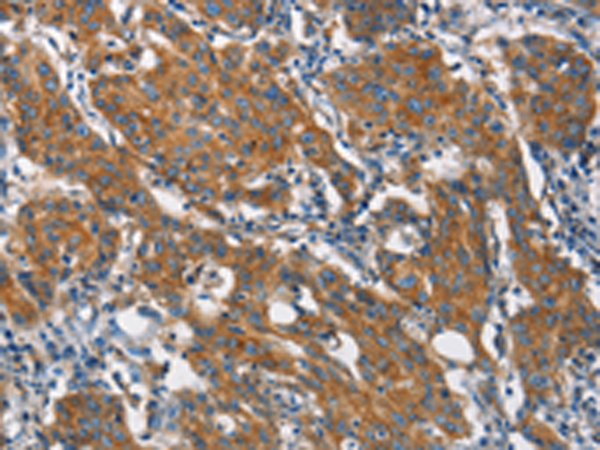


| WB | 咨询技术 | Human,Mouse,Rat |
| IF | 咨询技术 | Human,Mouse,Rat |
| IHC | 1/25-1/100 | Human,Mouse,Rat |
| ICC | 技术咨询 | Human,Mouse,Rat |
| FCM | 咨询技术 | Human,Mouse,Rat |
| Elisa | 1/1000-1/2000 | Human,Mouse,Rat |
| Aliases | Hc; CHC; CHC17; CLH-17; CLTCL2 |
| WB Predicted band size | 192 kDa |
| Host/Isotype | Rabbit IgG |
| Antibody Type | Primary antibody |
| Storage | Store at 4°C short term. Aliquot and store at -20°C long term. Avoid freeze/thaw cycles. |
| Species Reactivity | Human, Mouse, Rat |
| Immunogen | Synthetic peptide of human CLTC |
| Formulation | Purified antibody in PBS with 0.05% sodium azide and 50% glycerol. |
+ +
以下是关于CLTC抗体的3-4条参考文献示例:
1. **文献名称**:*"Clathrin Heavy Chain (CLTC) as a Potential Biomarker in Triple-Negative Breast Cancer"*
**作者**:Zhang Y, et al.
**摘要**:该研究通过免疫组化分析CLTC在乳腺癌中的表达水平,发现CLTC高表达与肿瘤侵袭性和不良预后显著相关,提示CLTC抗体可能作为诊断或预后评估工具。
2. **文献名称**:*"Role of Clathrin-Mediated Endocytosis in Hepatitis C Virus Entry"*
**作者**:Hansen SH, Sandvig K.
**摘要**:研究利用CLTC抗体阻断实验,证明网格蛋白重链(CLTC)在丙型肝炎病毒(HCV)进入宿主细胞中起关键作用,抑制CLTC可显著降低病毒内化效率。
3. **文献名称**:*"CLTC Dysregulation in Neurodegenerative Disorders: Insights from Mouse Models"*
**作者**:Smith JL, et al.
**摘要**:通过CLTC抗体标记技术,发现CLTF在阿尔茨海默病模型小鼠神经元中的异常聚集,提示其与突触功能障碍和病理蛋白运输缺陷相关。
4. **文献名称**:*"CLTC Antibody-Based Screening for Endocytosis Inhibitors in Cancer Therapy"*
**作者**:Li X, et al.
**摘要**:该研究开发了一种基于CLTC抗体的高通量筛选方法,用于鉴定抑制网格蛋白介导的内吞作用的小分子化合物,为靶向癌症转移提供新策略。
(注:以上文献及作者为示例性内容,实际引用需根据具体文献调整。)
CLTC (Clathrin Heavy Chain) antibodies are essential tools in studying the structure and function of clathrin, a key protein involved in intracellular trafficking. Clathrin forms triskelion-shaped complexes that assemble into lattice structures, facilitating vesicle formation during endocytosis and organelle biogenesis. The heavy chain (CLTC) provides the structural backbone, while light chains regulate assembly and disassembly. CLTC antibodies are widely used to investigate clathrin-mediated processes like receptor internalization, synaptic vesicle recycling, and lysosomal sorting.
These antibodies enable researchers to detect CLTC expression through techniques like Western blotting, immunofluorescence, and immunoprecipitation. They help visualize clathrin-coated pits/vesicles and track dynamic membrane trafficking events. In disease research, CLTC antibodies contribute to understanding pathologies linked to trafficking defects, including cancer metastasis (altered growth factor internalization), neurological disorders (impaired synaptic transmission), and viral entry mechanisms (e.g., HIV, influenza). Recent studies also explore CLTC's non-canonical roles in mitosis and cytoskeletal organization. Commercial CLTC antibodies are typically validated for species cross-reactivity (human, mouse, rat) and application-specific performance, with monoclonal antibodies offering high specificity and polyclonals providing broader detection capacity. Proper controls remain crucial due to potential cross-reactivity with homologous proteins.
×